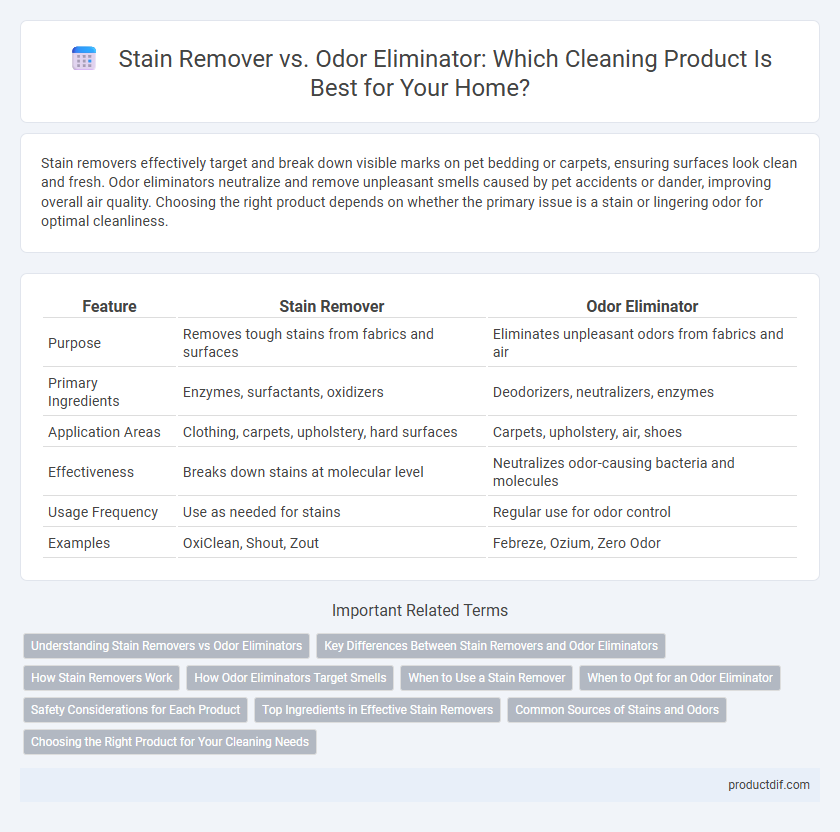Stain removers effectively target and break down visible marks on pet bedding or carpets, ensuring surfaces look clean and fresh. Odor eliminators neutralize and remove unpleasant smells caused by pet accidents or dander, improving overall air quality. Choosing the right product depends on whether the primary issue is a stain or lingering odor for optimal cleanliness.
Table of Comparison
| Feature | Stain Remover | Odor Eliminator |
|---|---|---|
| Purpose | Removes tough stains from fabrics and surfaces | Eliminates unpleasant odors from fabrics and air |
| Primary Ingredients | Enzymes, surfactants, oxidizers | Deodorizers, neutralizers, enzymes |
| Application Areas | Clothing, carpets, upholstery, hard surfaces | Carpets, upholstery, air, shoes |
| Effectiveness | Breaks down stains at molecular level | Neutralizes odor-causing bacteria and molecules |
| Usage Frequency | Use as needed for stains | Regular use for odor control |
| Examples | OxiClean, Shout, Zout | Febreze, Ozium, Zero Odor |
Understanding Stain Removers vs Odor Eliminators
Stain removers target and break down specific substances like grease, ink, or wine to lift visible marks from fabrics and surfaces, using enzymes or chemical agents designed for deep penetration. Odor eliminators neutralize or absorb unpleasant smells caused by bacteria, smoke, or pet dander, often using activated charcoal, ozone, or fragrance-free compounds to ensure lasting freshness. Choosing between a stain remover and an odor eliminator depends on addressing either the appearance of the material or the underlying source of the smell effectively.
Key Differences Between Stain Removers and Odor Eliminators
Stain removers are formulated with powerful enzymes and surfactants designed to break down and lift visible stains caused by substances like food, grease, or ink from fabric and surfaces. Odor eliminators target molecules responsible for unpleasant smells by neutralizing or masking odors, often using activated charcoal, baking soda, or antimicrobial agents. While stain removers focus on restoring appearance, odor eliminators prioritize refreshing ambient scents, making their chemical compositions and applications distinctly different.
How Stain Removers Work
Stain removers work by breaking down the chemical bonds of stains using enzymes, surfactants, or solvents specifically designed to target substances like grease, protein, or tannins. These cleaning agents penetrate fabric fibers, lifting and dissolving stains to make them easier to wash away. Unlike odor eliminators that neutralize or mask smells, stain removers focus on removing the visible marks caused by spills or dirt.
How Odor Eliminators Target Smells
Odor eliminators target smells by neutralizing volatile organic compounds (VOCs) that cause unpleasant odors rather than masking them with fragrances. These products often contain enzymes, activated charcoal, or chemical neutralizers that break down odor-causing molecules at a molecular level. This mechanism ensures long-lasting freshness, making odor eliminators essential for removing stubborn smells from fabrics, carpets, and household surfaces.
When to Use a Stain Remover
A stain remover should be used immediately after spills or visible marks on fabrics and surfaces to effectively break down and lift stains such as grease, wine, or ink. It targets pigment-based blemishes that regular detergents might not fully remove, preventing permanent damage or discoloration. Stain removers are ideal for treating specific, localized spots before laundering or deeper cleaning.
When to Opt for an Odor Eliminator
Choose an odor eliminator when persistent smells linger even after cleaning visible stains, especially in fabrics, carpets, or upholstery. Odor eliminators contain specialized enzymes or activated charcoal that neutralize odor-causing molecules at the source. Use them in high-traffic areas, pet zones, or smoke-exposed environments for effective odor control beyond just stain removal.
Safety Considerations for Each Product
Stain removers often contain strong chemicals like enzymes and solvents that require careful handling to avoid skin irritation and respiratory issues; always use gloves and ensure proper ventilation during application. Odor eliminators typically use less harsh ingredients such as activated charcoal or essential oils, presenting a lower risk but still necessitating caution around pets and children due to potential toxicity. Reading product labels for specific safety instructions and performing spot tests is essential to prevent damage to fabrics or surfaces while ensuring safe indoor air quality.
Top Ingredients in Effective Stain Removers
Effective stain removers typically include powerful enzymes such as protease, lipase, and amylase that break down protein, fat, and carbohydrate-based stains, respectively. Key chemical agents like oxygen-based bleach (sodium percarbonate) and surfactants enhance stain lift and dissolution without damaging fabrics. These targeted ingredients differentiate stain removers from odor eliminators, which prioritize antibacterial agents and odor-neutralizing compounds rather than enzymatic stain breakdown.
Common Sources of Stains and Odors
Stain removers target common sources such as coffee, wine, grease, and ink, breaking down pigments and oils embedded in fabrics or surfaces. Odor eliminators focus on neutralizing smells originating from pet urine, cooking residues, mildew, and smoke by breaking down odor-causing molecules at the source. Both products are essential for comprehensive cleaning where stains and odors often coexist in home environments.
Choosing the Right Product for Your Cleaning Needs
Stain removers target and break down specific substances like grease, wine, or ink, ensuring surfaces are visibly clean and blemish-free, while odor eliminators neutralize and remove unpleasant smells caused by bacteria or mold. Selecting the right product depends on the primary issue--opt for a stain remover for visible marks and an odor eliminator for persistent smells, as their chemical formulations are designed to address distinct cleaning challenges. Combining both products can be effective in environments prone to both stains and odors, such as kitchens and bathrooms.
Stain Remover vs Odor Eliminator Infographic

 productdif.com
productdif.com